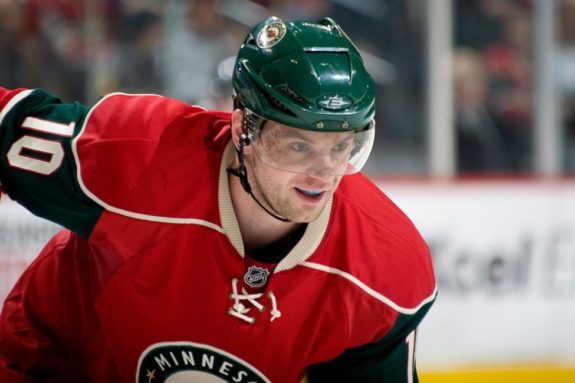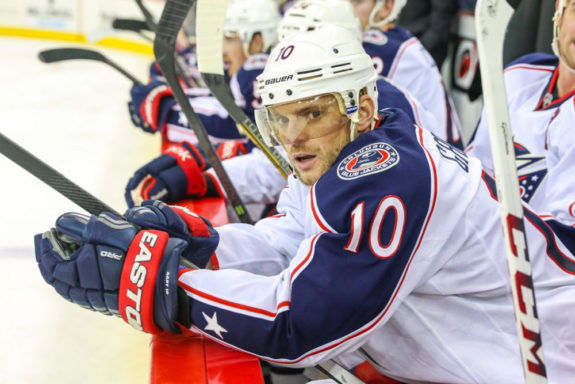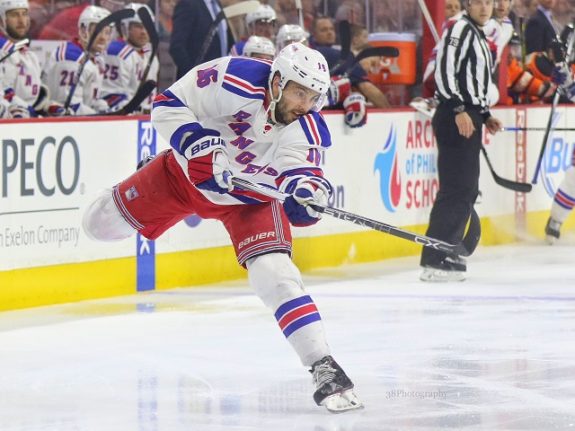Trade deadline nightmares that haunt Columbus Blue Jacket fans begin and end with one name: Marian Gaborik.
Gaborik is one of the more tantalizing, if not enigmatic, players of the last two decades. He played the Rick Nash role for the Minnesota Wild, who entered the league at the same time as the Jackets. A dominating offensive force, the Slovak played a more finesse-skill game than Nash’s power forward game, as he helped establish the Wild as their first legitimate NHL star. As an elite skater and shooter, Gaborik was feared on the ice.

Gaborik thrice scored 40-plus goals at the NHL level, including the season before he was acquired by Columbus. At the time of his trade to Columbus, he had recently cracked age 30. With a long history of injuries, there were some questions about longevity for the forward – which the Los Angeles Kings would eventually answer, but we’ll get to that in a second.
Gaborik’s Acquisition
It’s important to look back on the Blue Jackets’ decision-making process with all the right contexts here, as it was a perfect storm of factors that led to the impulsive decision to acquire Gaborik. Let’s go back a decade to the 2012-13 season.
In the lockout-shortened year, they were being willed into playoff contention by the standout play of eventual Vezina Trophy winner Sergei Bobrovsky. The team had little to no elite talent to help that goaltending, though. They were offensively led by 37-year-old Vinny Prospal, grinder Mark Letestu, and defensive defenseman Fedor Tyutin. Seriously. A team with that type of scoring support has no business being even close to the playoff picture. It was a Cinderella run that had no business happening, but the city and organization got swept up in the excitement.
Related: Revisiting the Blue Jackets’ Second Jeff Carter Trade
As of that season, they had made the playoffs once in 11 years of existing – in which they were swept by the Detroit Red Wings. Making the playoffs would be considered a winning season for the organization. They were also coming off a 2011-12 season in which they were the worst in league standings by nine points.
The excitement was compounded when you add that early in the year the team fired their general manager (GM) Scott Howson, who had been at the helm for seven seasons. To replace him, they brought in a rookie GM Jarmo Kekalainen, who was looking to make his mark on the organization. So Kekalainen swung for the fences and went out to grab an elite 31-year-old winger with a history of scoring prowess in Gaborik.

To acquire the aging star, Columbus had to sell the farm. They shipped out sixth overall selection Derick Brassard (who was still under 25 years old), along with another first-round selection in defenseman John Moore and tough guy Derek Dorsett. The move was labelled as a deadline push to crack the playoffs, with Gaborik thought to be someone who would vastly improve the team’s play on the man advantage. However, all was for naught as Gaborik struggled offensively, and the Jackets missed the final playoff spot on a tiebreaker.
Gaborik’s Departure
Things didn’t improve for Gaborik in his next season in Ohio, so the one-year-older Gaborik was shipped out at the next trade deadline. The reason being “he just didn’t fit.” This time, sent to the Kings for Matt Frattin, who was once lauded as the next big thing for the Toronto Maple Leafs, along with two draft picks. While Kekalainen worked his magic, trading those picks into the pick selections that would be used to draft Elvis Merzlikins and Gabriel Carlsson. Gaborik’s stat line with the Jackets finished at 22 points through 34 games.
After being traded to the Kings, it was like deja vu from the Jeff Carter trade. Just as Carter did, Gaborik went from mediocrity on the Jackets, to becoming a key piece for the Kings. 16 points through 19 regular season games in LA, and 14 goals in the playoffs, en route to the Kings’ second Stanley Cup in three years. To make matters worse, Carter and Gaborik squared off against Brassard and Nash on the Rangers in the Stanley Cup Final that year. Ouch.
For the Jackets, Carlsson was a bust who played only 75 games through six seasons with the organization. Fun fact, he was also picked five spots above the Carolina Hurricanes’ star Sebastian Aho. Frattin played four games with the Jackets before he was traded back to the Leafs for a minor league player. The one bastion of hope in this trade for the Blue Jackets is Elvis Merzlikins, who aside from this season, has shown potential as a legitimate NHL starter.
Analyzing the Gaborik Trades
My issue with this trade isn’t the return, which ended up being okay. The issue is that they had no business making those trades in the first place. It seemed to be another case of the Blue Jackets not trusting their own drafting and chasing an established star. While it’s a pattern which has changed in the later years of the Kekalainen era, look no further than the Jakub Voracek for Jeff Carter trade as more evidence of that in the early 2010s. They bought high on Gaborik and sold low, which is never ideal in an NHL that has turned the GM’s primary role into asset management.
Brassard might have been the better option to keep in the short term, as his production with the Rangers would have put him on the podium in the Jackets’ scoring race through three of the next four seasons, including beating all of the Jackets’ players in 2015-16.

The one wild card for this deal is the draft pick that landed Merzlikins. However, in the long term, I don’t think it’s fair to say he wouldn’t be a Blue Jacket without this deal. Kekalainen has shown a history of making deals to acquire the players that he wants at the draft – like when he traded up with eyes on Cole Sillinger in the first round of the 2021 Draft. Scrounging up some assets to get a third-round pick to draft Merzlikins in 2014 wouldn’t have been entirely out of the question.
At the end of the day, the trade to acquire Gaborik was impulsive and one that didn’t need to happen. Ultimately that marks one of the biggest swing-and-miss opportunities in Blue Jackets’ history and one that has left fans shaking their heads in hindsight.